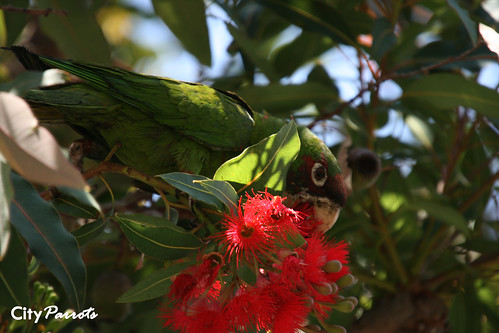Parrot population growing in Long Beach
 Tuesday, August 20, 2013 at 0:20
Tuesday, August 20, 2013 at 0:20  Parrot at Long Beach. You could say Long Beach is going to the birds.
Parrot at Long Beach. You could say Long Beach is going to the birds.
The feral parrots of Belmont Shore have been a staple since the 1980s, and while some residents see them as a lovable mascot, others think they're a noisy feathered nuisance. Like them or not, the birds are here to stay, experts say.
Researchers say their numbers are growing, not only in Long Beach, but throughout Southern California. The flocks are thriving in a paradise of warm weather, no natural predators and an abundance of tropical plants, said Kimball Garrett, an ornithology collections manager at the Natural History Museum of Los Angeles County.
“There's no tree-climbing snakes, no monkeys that would be their natural predators,” he said (Although rapters do predete them, edit City Parrots). “They get all the fruit and seeds they need from non-native plants, and they have plenty of places where can build their nests. It's as if the people who developed the urban landscape said, ‘Gee, what can we do to make parrots really happy?'”
Garrett, who's studied the region's population since the early 1980s and runs californiaparrotproject.org, thinks the numbers have grown to more than 3,500 birds and 13 different species. They are thought to be descendants of escaped pets.
Where they were once found mainly in the San Gabriel Valley, flocks now are popping up in the San Fernando Valley to Santa Monica.
In Long Beach, Charlie Collins, a retired Cal State Long Beach ornithology professor, used to count the local birds each year. Collins counted just five parrots in 1987, but by 1996, the flock had ballooned to nearly 50. On his last official count before he retired around 2000, Collins saw 100 birds. Today, he estimates there are at least 200.
The red-crowned parrot from Mexico is the most common species found in Southern California. But in Long Beach, the South American mitred parakeet reigns supreme.
“They eat a little bit of everything. I've seen them going after apples in my backyard, and sometimes they're over by Cal State Long Beach eating the nectar in eucalyptus flowers for a sugar fix,” he said.
Parrots prefer to nest in hollow trees but will improvise with holes in attics or open vents. Highly social animals, their familiar squawks echo through the streets as they banter with their partners and chase other birds in their territory.
They typically gather in large flocks early in the morning and then again at dusk before returning to their roosting sites.
Allen Hay knows this scene all too well. As owner of the ABC Fine Wines & Spirits liquor store at Ocean Boulevard and Livingston Street, his shop sits near a patch of tall palms that serves as the area's best-known parrot meeting spot.
“Sometimes it's so loud it sounds like you're in the middle of a chicken coup,” said Hay, who's owned the store since 1992. “But I don't mind it. They've been here so long, they're part of Belmont Shore.”
Meaghan O'Neill, a naturalist and supervisor at El Dorado Nature Center, said many people have a love/hate relationship with the birds.
“People think it's cool and exciting to see parrots flying in the sky, but when it's 6 a.m. and they're eating persimmons outside your window, it's not so cool because they're very noisy,” she said with a chuckle.
While the flocks are growing, they don't appear to be having a negative impact on native wildlife, Garrett said. The parrots could become a problem if they expand into rural areas, he said.
For now, they have found a mostly welcoming home in Long Beach.
Mike Nielsen, president of the El Dorado Audubon Society, said many birders now include the parrots on their list of birds to watch.
“There is a certain thrill when you see a flock of these guys overhead,” he said. “They're attention grabbing, and that's probably a good thing in the sense that it draws people towards nature, and it draws people towards birds.”

